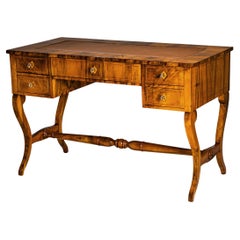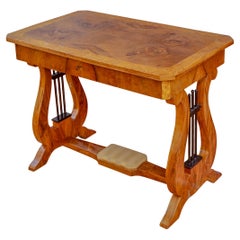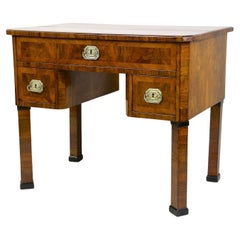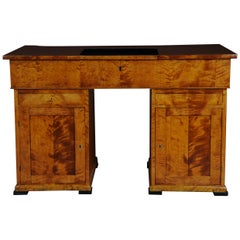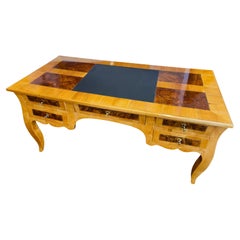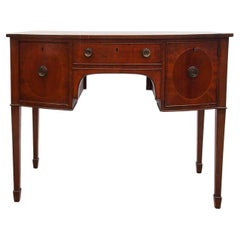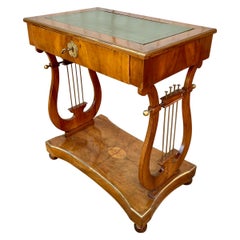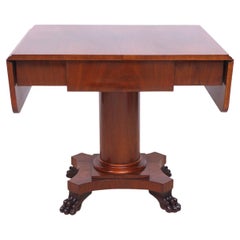Biedermeier Writing Desk
Antique 1830s Biedermeier Desks and Writing Tables
Metal
Antique 1850s Austrian Biedermeier Desks and Writing Tables
Walnut, Fir
Antique Mid-19th Century Austrian Biedermeier Desks and Writing Tables
Brass
Antique 19th Century German Biedermeier Desks
Birch
Antique Early 19th Century Austrian Biedermeier Desks and Writing Tables
Wood, Maple, Lacquer, Spruce
Antique 19th Century German Biedermeier Desks and Writing Tables
Cherry, Walnut
Antique 1870s Austrian Biedermeier Desks and Writing Tables
Brass
Antique Early 1800s Scandinavian Empire Desks and Writing Tables
Brass
Antique 1840s Swedish Karl Johan Desks and Writing Tables
Mahogany
Antique Early 19th Century Austrian Biedermeier Desks and Writing Tables
Wood, Maple, Lacquer
Antique Early 19th Century Czech Biedermeier Desks and Writing Tables
Wood, Lacquer, Cherry
Antique Mid-19th Century Austrian Biedermeier Desks and Writing Tables
Wood, Ash, Lacquer
Antique Early 19th Century Czech Biedermeier Desks and Writing Tables
Wood, Ash, Lacquer
Mid-20th Century French Art Deco Desks and Writing Tables
Birch
Antique Early 19th Century Austrian Biedermeier Desks
Maple, Walnut
Antique 1830s Czech Biedermeier Desks and Writing Tables
Wood, Walnut, Lacquer
Antique 1830s German Biedermeier Desks and Writing Tables
Walnut
Antique 19th Century German Chippendale Desks and Writing Tables
Wood
Antique 19th Century Austrian Biedermeier Desks and Writing Tables
Cherry
Antique 19th Century German Biedermeier Desks and Writing Tables
Bronze
Antique 19th Century Desks and Writing Tables
Antique 19th Century Desks and Writing Tables
Brass
Antique 1840s French Biedermeier Desks and Writing Tables
Wood
Antique 19th Century Desks and Writing Tables
Oak
Antique 19th Century Austrian Biedermeier Desks and Writing Tables
Maple, Walnut
Antique Mid-19th Century German Biedermeier Desks and Writing Tables
Mahogany
Antique Late 19th Century Biedermeier Desks and Writing Tables
Leather, Birch
Antique Late 19th Century Swedish Biedermeier Desks and Writing Tables
Leather, Birch
Antique 19th Century Austrian Biedermeier Desks and Writing Tables
Wood, Pearwood, Maple
Antique 1820s Hungarian Biedermeier Desks and Writing Tables
Birdseye Maple, Walnut
Antique 19th Century Austrian Biedermeier Desks and Writing Tables
Ash, Fruitwood
Antique Mid-19th Century German Biedermeier Desks and Writing Tables
Cherry
Antique Early 19th Century Austrian Biedermeier Desks and Writing Tables
Brass
Antique 1830s European Biedermeier Desks and Writing Tables
Walnut
Antique 1820s Austrian Biedermeier Desks and Writing Tables
Walnut
Antique Early 19th Century Austrian Biedermeier Desks and Writing Tables
Brass
Antique 19th Century German Biedermeier Desks and Writing Tables
Spruce, Cherry
Antique 1810s Austrian Biedermeier Desks and Writing Tables
Walnut
Antique Early 19th Century English Biedermeier Desks and Writing Tables
Brass
Antique Late 19th Century German Desks and Writing Tables
Bronze
Antique 19th Century German Biedermeier Desks and Writing Tables
Wood
Antique Early 19th Century German Biedermeier Desks and Writing Tables
Cherry
Antique 1830s German Biedermeier Desks and Writing Tables
Softwood, Cherry, Glass
Antique 19th Century Swedish Biedermeier Desks and Writing Tables
Wood
Antique 19th Century Desks and Writing Tables
Wood
Antique 19th Century Austrian Biedermeier Desks and Writing Tables
Wood, Burl
Antique Mid-19th Century Austrian Biedermeier Desks and Writing Tables
Walnut
Mid-20th Century Swedish Biedermeier Desks and Writing Tables
Birch
Antique 19th Century Austrian Biedermeier Desks and Writing Tables
Walnut
Antique 1840s Biedermeier Desks and Writing Tables
Mahogany
Antique Mid-19th Century Danish Biedermeier Desks and Writing Tables
Wood
Antique Early 19th Century Austrian Biedermeier Desks and Writing Tables
Walnut
Antique 19th Century Czech Biedermeier Desks and Writing Tables
Wood, Walnut, Lacquer
Antique Early 19th Century Austrian Biedermeier Desks and Writing Tables
Pearwood
Antique Early 19th Century Austrian Biedermeier Desks and Writing Tables
Pearwood
Antique Late 19th Century Swedish Biedermeier Secretaires
Birch
Antique 19th Century Austrian Desks and Writing Tables
- 1
Biedermeier Writing Desk For Sale on 1stDibs
How Much is a Biedermeier Writing Desk?
A Close Look at Biedermeier Furniture
The authentic Biedermeier furniture on 1stDibs is representative of the first modern European decorative style not dictated by the tastes of the aristocracy. Following the Napoleonic wars, a growing, wealthy urban middle class in the German-speaking states of Central Europe began to demand rights and privileges once granted only to nobles. To avoid trouble, the upwardly striving confined their political discussions to one another’s homes. And so the salon was born.
Cabinetmakers in cities such as Vienna, Berlin and Mainz began to offer goods that reflected the tastes and needs of the new class. The makers of Biedermeier chairs, tables and other furniture used little or no gilding, silver hardware or other lavish ornament. Ebonized trims are common on Biedermeier cabinetry, and neoclassical elements — lyre-shaped chair splats, carved scrollwork, table supports shaped like Greek columns. But the strongest aesthetic statement came from the wood — richly-grained, honey-colored, often book-matched veneers of walnut and fruitwood.
There are two iconic Biedermeier furniture forms, both made to outfit rooms designed for conversation. One is the sofa, deeply upholstered with a strong, architectural wooden frame. The second is the circular pedestal table, which stood at the center of the room, offering a surface on which to place coffee and cake services; or to roll out a map, or sketch out ideas on paper.
“Biedermeier” was originally a derogatory term — it derives from the pen names of two German magazine writers who mocked bourgeois manners. Looking at the elegant and refined antique, new and vintage Biedermeier furniture offered on 1stDibs, that is now an amusing irony.
Finding the Right Desks-writing-tables for You
Choosing the perfect writing desk or writing table is a profoundly personal journey, one that people have been embarking upon for centuries.
Queen Atossa of Persia, from her writing table circa 500 B.C., is said to have been the originator of the art of handwritten letters. Hers was reportedly the first in a long and colorful history of penned correspondence that grew in popularity alongside literacy. The demand for suitable writing desks, which would serve the composer of the letters as well as ensure the comfort of the recipient naturally followed, and the design of these necessary furnishings has evolved throughout history.
Once people began to seek freedom from the outwardly ornate styles of the walnut and rosewood writing desks and drafting tables introduced in the name of Queen Victoria and King Louis XV, radical shifts occurred, such as those that materialized during the Art Nouveau period, when designers longed to produce furniture inspired by the natural world’s beauty. A prime example is the work of the famous late-19th-century Spanish architect Antoni Gaudí — his rolltop desk featured deep side drawers and was adorned with carved motifs that paid tribute to nature. Gaudí regularly combined structural precision with decorative elements, creating beautiful pieces of furniture in wood and metal.
Soon afterward, preferences for sleek, geometric, stylized forms in furniture that saw an emphasis on natural wood grains and traditional craftsmanship took hold. Today, Art Deco desks are still favored by designers who seek to infuse interiors with an air of luxury. One of the most prominent figures of the Art Deco movement was French decorator and furniture designer Émile-Jacques Ruhlmann. With his use of neoclassical motifs as well as expensive and exotic materials such as imported dark woods and inlays of precious metals for his writing desks, Ruhlmann came to symbolize good taste and modernity.
The rise in appreciation for Scandinavian modernism continues to influence the design of contemporary writing desks. It employs the “no fuss” or “less is more” approach to creating a tasteful, sophisticated space. Sweden’s master cabinetmaker Bruno Mathsson created gallery-worthy designs that are as functional as they are beautiful. Finnish architect Alvar Aalto never viewed himself as an artist, but, like Mathsson, his furniture designs reflected a fondness for organic materials and a humanistic approach. Danish designers such as Hans Wegner introduced elegant shapes and lines to mid-century desks and writing tables, often working in oak and solid teak.
From vintage desks to contemporary styles, 1stDibs offers a broad spectrum of choices for conducting all personal and business writing and reading activities.
- What is a writing desk?1 Answer1stDibs ExpertSeptember 25, 2019
A writing desk may refer to a desk with a top, often sloping, for writing on or to a portable case with compartments to hold writing materials and a surface for writing.
- 1stDibs ExpertOctober 12, 2021A small writing table is also called a davenport table or davenport desk. They normally feature a sloped or inclined top attached with hinges to the back of the table. On 1stDibs, find a variety of antique and vintage davenport desks.
- 1stDibs ExpertOctober 19, 2021A writing desk with drawers is also called a secretary. It is a desk with drawers, one of which can be pushed out and the front of the desk lowered to create a flat writing surface. These writing desks have been made in a variety of styles over the years. Shop for a variety of writing tables with drawers on 1stDibs.
- 1stDibs ExpertJune 15, 2023What an old-fashioned writing desk is called varies by design. Pieces with drop-down fronts are secretary desks (these are typically made of two parts: a chest of drawers on the bottom and a hutch or cupboard with shelves on the top), while ones that rest on two pillars, cabinets or bookcases are pedestal desks. A desk with a small writing surface positioned in front of drawers and cubbies is a bureau à gradin. On 1stDibs, shop a selection of desks.
- 1stDibs ExpertMarch 3, 2023In French, the term for a writing desk that often featured a drop-down writing surface is secretaire. This type of desk is called a secretary desk in English. Simply put, a secretary desk is a multifunctional piece of furniture with a hinged writing surface that folds open or drops down. When the leaf is folded out, small inner storage compartments, which are called pigeonholes, cubbies, recesses or drawers, are revealed. On 1stDibs, shop antique secretary desks from some of the world's top sellers.
